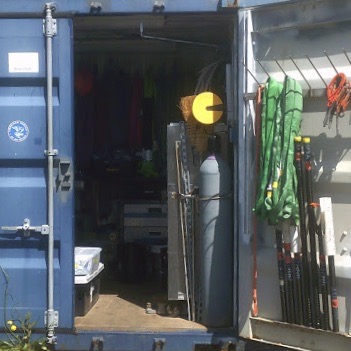COVID-prevention, Quarantine, and Collaboration: Endurance Array 13 is Ready to Go
After two weeks of quarantine at home where possible, Airbnbs, and deserted family vacation homes, the 12-member Endurance Array team will head to Newport, Oregon on July 1 to board the R/V Thomas G. Thompson. As part of COVID-19 precautions, all of the needed equipment to service the Endurance Array will have been transported to the pier by non-seagoing staff prior to their arrival. The seagoing staff will simply arrive at the dock, load the ship, and then go to sea.
Under normal circumstances, the array is serviced – that is moorings are recovered and new ones deployed to ensure that the collection and transmission of ocean data continues seamlessly – twice a year. The regularly scheduled expedition this spring was canceled due to the coronavirus epidemic, so the cruise this summer will combine the work of the spring and fall expeditions.
“We are pleased to be able to get to the arrays this summer and to work aboard the R/V Thomas G. Thompson. This ship is large enough to give us all enough space to adequately social distance while onboard,” said Ed Dever, project scientist and principal investigator for the Endurance Array project. The ship will sail from its homeport in Seattle to meet the Endurance Array team in Newport, Oregon.
“With COVID-19 keeping some researchers on land, people are more interested than ever in the data that we collect remotely using the OOI. It’s important to have this opportunity to recover and replace the equipment at our Oregon and Washington lines,” Dever added.
The expedition will involve replacing seven moorings at six locations and the deployment of four gliders and four coastal surface piercing profilers. The team also will be measuring salinity, temperature, density, oxygen, and chlorophyll as a function of depth, during CTD casts before and after mooring recoveries. These onsite real-time data are publicly shared, as are all data continuously collected by the arrays throughout the year.
This expedition will involve three legs, traveling back and forth between different locations in the array and Newport to unload and pick up the huge coastal moorings. (Estimated weight of ~ 11 tons/per mooring). In total, the team will travel an estimated 1000 nautical miles during the expedition.
Dever’s OOI colleague Jon Fram at Oregon State University will be the chief scientist on this expedition. He remarked, “COVID-prevention has significantly changed operations onshore as well as while we are aboard the Thompson. Even for the seemingly simple task of ensuring that everyone had adequate masks for the duration, we tried out six different mask styles to find one that would be comfortable enough for everyone to wear for the duration of the journey. We also had to figure out how to achieve appropriate social distancing while onboard, which will change our normal operations.”
The Endurance Array team usually invites graduate students along on these expeditions to provide extra sets of hands, while offering mentoring opportunities and shipboard experiences for future potential marine scientists. During this summer expedition, only one graduate student will be onboard, who has previous experience on similar cruises.
Collaborative non-OOI scientific experiments, however, will take place. The Endurance Array team will gather the data rather than the non-OOI scientists involved, who would normally be onboard. Three different non-OOI experiments will occur. The first involves Linsey Haram of the Smithsonian, who collects fouling communities that grow on panels attached to OOI buoys. Ashley Burkett of Oklahoma State University is involved in the next, which entails collecting settling organisms on devices attached to the Seafloor Multi-Function Nodes (MFN) at the base of some surface moorings and act both as an anchor as well as a platform to affix instruments. The third, proposed by Taylor Chapple of Oregon State University, involves testing deployment of tagged fish acoustic monitors on the Near-Surface Instrument Frame (NSIF), a cage containing subsurface oceanographic instruments attached to multiple data concentrator logger computers.
Added Dever, “These three experiments are great examples of how scientists can become involved in the OOI and access the data they need. They demonstrate how scientists can have access to ocean data without ever having set foot aboard a ship.”
After the Endurance Team’s expedition, the Regional Cabled Array team will board the R/V Thomas G. Thompson on 30 July to begin a month-long expedition to service the RCA array, which provides power and equipment to a multitude of data gathering ocean equipment on the ocean floor.


